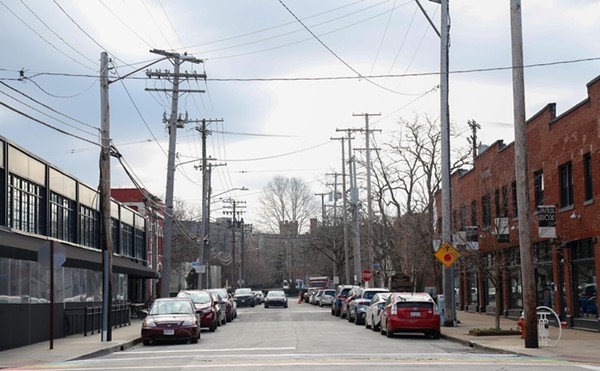The shuttered cathedral is vast and desolate. It's a sunny Thursday afternoon, and we're standing where clergy once presided over religious services many years ago. Now, apart from the gentle wheeze of traffic, it's quiet. The floor, the walls, the pillars — everything here is crumbling.
Camera in hand, photographer Seph Lawless leaps down to the ground floor, which is littered with debris and the detritus of years of abandonment. He nimbly skits across the wreckage — bricks, scaffolding, jagged wood once arranged as pews — and seeks out a vantage point for his next shot. This is what he does.
"I just kinda stumbled across this place about a year or so ago," he says, echoes of his voice ebbing against the masonry. He's zooming in on a surprisingly intact piano, framed by wilting walls and sacred art from a bygone era. The grooves of time and activity are worn like merit badges up and down the ivory keys. "It's like you can almost hear it."
More than likely, we're not even supposed to be here. Lawless, 35, explains that this church is usually one of the easier abandoned spots in town to enter. But a problem arose when we arrived to find the place boarded up with flimsy plywood and half-hearted warnings against trespassing. And despite his moniker, Lawless says he really tries to avoid crossing legal lines and barricades set up by the city. These boards, however, seem to have been jury-rigged by some concerned neighbor, not the police.
Also, we had come here to go inside.
Urban exploration has been a steadily growing phenomenon across the world for a while now. The idea is to go deep into the heart of man-made terra incognita: abandoned ruins, derelict neighborhoods, etc. Photography is a great medium for bringing those forgotten landscapes to the public. Lawless has been in the game for more than a decade. "Back then, there wasn't a name for it," he says. "Except for being crazy."
Locally, he's spent time roaming around the concrete labyrinth along East Cleveland's weary Shaw Avenue. "I go into abandoned homes just for the hell of it," he says, remarking on a typical day's work. Prior to Michael Madison being charged with the murders of three women in July, Lawless was actually photographing the very house that would eventually be used to hide Angela Deskins' body. It's now boarded up by the city, leaving stories sealed within.
"You always wonder if something bad is happening in these places. Now there's all this talk that, yes, something bad is happening in some of these places," he says. He pauses a moment and adds: "I wanted to get into Ariel Castro's house more than anything."
Over the past three months, Lawless has continued to prowl across Seymour Avenue, plotting out possible entry points. "You can't even get on the roof of the one abandoned house next to it and jump over to get in. They put up a wall," he says, rattling off some of the aspects of the venture he was considering. He feared breaking into the home would impact the court proceedings, but when Castro accepted a guilty plea in late July, he thought there may be a slim chance to get behind the fences and explore the horrors.
"I couldn't believe it. They're still sitting out there," he says of the FBI and police. The house was set for demolition on Aug. 7. About an hour before we met at the church, Cuyahoga County Prosecutor Tim McGinty released photos of the home during Castro's formal sentencing. "Are you serious?! I had no idea..."
Often, Lawless drifts into and out of these locations with little concern. He's chanced upon homeless men and women living in abandoned structures, but an unspoken agreement typically keeps them from interacting along the way. During those times, anxiety runs high as Lawless realizes he's in someone's living quarters. In a room jutting off from the sanctuary where we're standing, water bottles are lined up along a makeshift mattress. Someone has been living here too.
As the sun pours in through ancient windows and freshly installed plywood, the church glows. Lawless absently says he feels more comfortable — safer, even — in places like this than outside in society. The farther he goes off the map, the more vivid the worlds he encounters tend to be.
"With houses, especially, I think they kinda tell a story. People can see the plight of America — that crushing of the economy," he says. "People are shocked when they see my stuff on Instagram from other countries. Like, 'This isn't America!'" His social media accounts spread his work across the globe. Along the way, he's inadvertently stoked the flames of anti-American sentiment at home and abroad. Boston bombing suspect Dzhokhar Tsarnaev was known to comment now and then on photos Lawless had posted. Days following the April 15 attack, Lawless' Facebook page was forcibly taken down, and thousands of Russia-based users had been removed from his network of fans.
He's stayed off Facebook since then, preferring the ephemera of Instagram (@SephLawless). Later this month, his first published collection of photos and written work will be released on Amazon. It's titled Autopsy of America.
Biloxi, Miss.; Appleton, Wis.; Las Cruces, N.M.: The datelines of Lawless' photography crisscross the map. When he's not sifting through ruins, he lives on the road. Hitting the freeways of America in a Toyota Prius, Lawless has gotten in touch with the spirit of this nation. After we walked through the cavernous church here in Cleveland, he was planning on heading up the road to Detroit.
While this is all a creative lifelong hobby for him, urban exploration has also served as a diagnostic for some of the country's true ills. It's informed him and his followers of some of the darker corners of society.
"When you go to areas like East Cleveland or Detroit, you can't make a right or a left without seeing some sort of urban decay," he says, ambling back toward the entryway of the church. "It's a real problem, and it's growing. You just wouldn't believe the devastation, the urban decay. It's profound. It really is."
He quickly references Gary, Ind. "That place is horrifying. It's literally a ghost town."
The plywood barricade slams against the church's stone walls as a chilled gust tears across the driveway. There's the sound — a stark reminder of the silence inside this room — and the sensation that we are distinctly not a part of the outside world here.
A entry from his journal dated Jan. 7, 2013, reads: "When I was a child, I was afraid of the dark...and ghosts. I'm now an adult who is afraid of the light...and people." It's a thought that lends a touch of explanation to why he's doing this. And each place he visits is itself an important footnote on what was once here and what it's become now.












